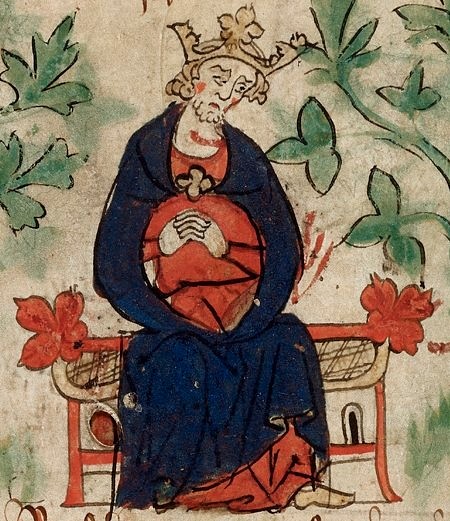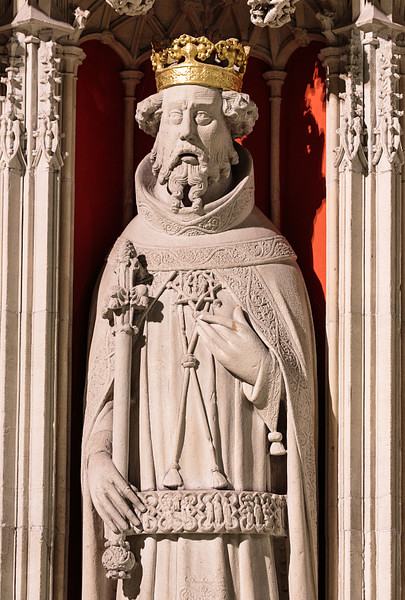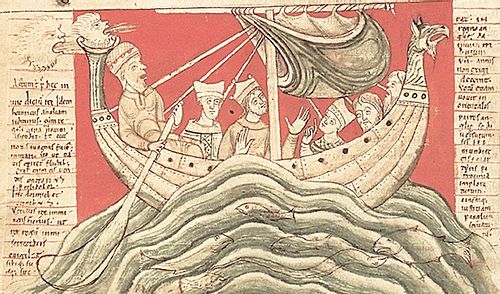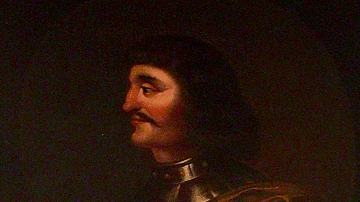
Henry I reigned as the king of England from 1100 to 1135 CE. The son of William the Conqueror (r. 1066-1087 CE), Henry succeeded his brother William II of England (r. 1087-1100 CE) after he had died in a hunting accident and left no heir. A third brother, Robert Curthose (l. c. 1052 - c. 1135 CE), Duke of Normandy, was also ambitious for the throne, and the two battled to unify their two territories as their father had done. Henry took final victory in 1106 CE and imprisoned Robert for the rest of his life. Henry then enjoyed a long and largely peaceful reign, which saw the creation of such innovations as the Exchequer and travelling judges to apply the king's law everywhere. Without an heir, Henry was succeeded by his nephew Stephen, Count of Blois (l. c. 1096-1154 CE).
Family Relations & Succession
Henry was born in September 1068 CE in Selby, Yorkshire, his father being William, Duke of Normandy, otherwise known as William the Conqueror or William I of England following his invasion of that country in 1066 CE. Henry's mother was Matilda of Flanders (c. 1032-1083 CE), who was the daughter of the Count of Flanders and the niece of Henry I of France (r. 1031-1060 CE). Matilda would be crowned the Queen of England in Westminster Abbey on 11 May 1068 CE. When William I died in 1087 CE, he was succeeded by his son William II 'Rufus' who reigned for the next 13 years. A third brother, Robert Curthose, Duke of Normandy had ambitions of his own and so the three brothers became entwined in a deadly game for supremacy.
Henry was the youngest son of the king and so, unlikely to get near the throne, he was prepared for a career in the medieval Church. This plan had the advantage of educating the young prince so that he was the only one of his brothers who was literate. Consequently, the prince earned the nickname Henry Beauclerc ('Good writer').

William II died unexpectedly on 2 August 1100 CE in the New Forest, as the result of a hunting accident when the nobleman William Tirel (sometimes spelt Tyrrell) fired a fateful arrow which bounced off the back of a fleeing stag and landed right in the centre of William's chest. At the time, the incident was regarded as an accident and Tirel was not punished for his part in the tragedy. It is, nevertheless, curious that William's younger brother and successor Henry was in the hunting party and Robert Curthose was just then away fighting in the First Crusade, allowing Henry to forward himself as the next king. Certainly, Henry had not been slow to secure the royal treasury and his election by the ruling council, all within 48 hours of his brother's death. Thus, on 6 August 1100 CE, Henry I of England was crowned king in Westminster Abbey.
Henry married twice. His first wife was Edith (l. 1080-1118 CE), the daughter of Malcolm III of Scotland (r. 1058-1093 CE), granddaughter of Edmund Ironside, king of England for one year in 1016 CE, and the niece of Edgar Aetheling (d. c. 1125 CE). Her excellent royal pedigree was further enhanced by adopting the Norman name of Matilda, perhaps also a tribute to Henry's mother. The couple married in November 1100 CE, and Matilda was crowned queen in the same year, her reign lasting until 1118 CE. This alliance strengthened the king's position in England by assuring certain barons he was the most useful and pedigree-rich royal to support (and not his brother Robert), as did his promises to the barons of a fairer treatment from the king in his Charter of Liberties (better described as an edict as it had no recipient, and, in any case, largely ignored by the king thereafter). Another point in Henry's favour was his recall the same year of the exiled Archbishop of Canterbury Anselm, who had fallen out of favour with William II. Consequently, there was a reconciliation between Church and Crown after William II had been accused of paganism and stealing revenues from lands held by the Church.
Robert Curthose & Normandy
The first problem the king had to deal with was Henry's own hyper-ambitious brother Robert Curthose. Robert had a legitimate claim to the English throne because William II had nominated him as successor. Indeed, the Duke of Normandy had already tried to wrest the throne from his father back in 1078-9 CE when he had gained the support of Philip I of France (r. 1059-1108 CE). Robert had again challenged his father during the siege of Mantes in 1087 CE. William II had experienced the same sort of problems with the ambitious Robert and so the king invaded Normandy in 1091 CE. Then the two brothers had joined sides to defeat Henry at Mont-Saint-Michel, confiscating his lands in the Cotentin (Cherbourg) peninsula for themselves.
Robert had fought with aplomb in the First Crusade (1095-1102 CE) but now he was back in Europe and keen to press his claim for the English throne. In July 1101 CE he invaded England and landed at Portsmouth but, Robert, always flexible in his politics, instead of fighting, negotiated a deal whereby he received a handsome pension and Henry kept his crown. The truce lasted five years, but rebel barons in Normandy became enough of a threat for Henry to send an army to Normandy in 1106 CE. Henry defeated Robert once and for all in a pitched battle at Tinchebrai in Normandy in September 1106 CE. Robert was then imprisoned for the remaining 28 years of his life, and Henry became both king of England and Duke of Normandy. Robert's son William 'Clito' (b. 1102 CE) would become a rallying point for rebel barons until his death in 1128 CE.
Henry & the Church
The rest of Henry's reign was peaceful, even if it was likely more a regime of repression than harmony, given the events following Henry's death. There were rumblings of discontent over the king's high taxes, too but at least no rebellion bubbled to the surface just yet. The Church was still proving a little troublesome, though. English kings had appointed senior clergy, and the Papacy took offence at this, claiming that a layman could not have such authority over God's servants. Threatened with excommunication, Henry compromised and gave up his right of appointment, although he did not give up his claims of certain church lands and their revenues. Despite these differences, the king did sponsor certain church projects, notably building a new monastery at Reading and funding the new choir at Canterbury Cathedral in 1130 CE.
Finances: the Exchequer
The good relations between king and Church are further indicated by Henry's use of the financial management skills of Roger, Bishop of Salisbury (d. 1139 CE) who served in that capacity for 36 years and who even acted as viceroy when the king was absent in Normandy. Henry's reign saw the creation of the Exchequer, essentially then a debt-collecting agency. The body, which derived its name from the use of a checkerboard cloth to count up debtor's accounts, first met in 1109 CE and was managed by the all-powerful Justiciar. The Exchequer produced various documents for the king to know better what his assets were and who had paid him what and who owed him what, the latter information being recorded in the 'pipe rolls' which were organised by shires. Even today, the finance minister of the UK government is called the 'Chancellor of the Exchequer.' More significant than the catchy title, this was a major step in creating some form of bureaucratic government.
Unfortunately, the greater knowledge of the financial state of his kingdom did not stop the king giving away vast swathes of royal lands and dispensing tax exemptions right left and centre in an, albeit successful, effort to keep potentially rebellious barons loyal. This would have serious consequences for all of his successors as the balance of power, at least in terms of wealth, gradually shifted from the king to the aristocracy. In Henry's reign, 85% of royal income came from land; 150 years later it would be only 40%, taxes would have to supply the remainder. One final act of Henry's was another beginning, to establish the idea that everyone, no matter if they lived on royal lands or not and no matter how far from the royal court they lived, was subject to the king's law. Travelling judges were dispatched around the country to ensure everyone knew what that law was and to apply it and its punishments (today's circuit judges are a remnant of these officials). This was a significant step towards creating a truly 'common' law that was applicable anywhere in the country.
Death & Successor
Following Queen Matilda's death in 1118 CE, Henry married his second wife, Adeliza, the daughter of Godfrey I, Count of Louvain (l. 1060-1139 CE) who was crowned queen in 1121 CE. The couple had no children together. Henry died on 1 December 1135 CE at Saint Denis-le-Fermont in Rouen, Normandy. Legend has it that the king died from overeating lampreys (a type of eel). He was buried in Reading Abbey, which he had funded the building of.
Crucially, the king did not leave a recognised male heir (although he did leave behind 21 illegitimate children). His two legitimate sons, William (the eldest, b. c. 1103 CE) and Richard were both tragically drowned in the English Channel in 1120 CE when onboard the ill-fated White Ship. The young princes had been sailing back from France, a trip which had sealed Henry's peace deal with King Louis VI (r. 1109-1137 CE) which formally bestowed Normandy on William when he became king. The White Ship's pilot was drunk and the vessel hit a rock and sank near Barfleur. All onboard died except a Norman butcher.
As a consequence of the White Ship disaster, only Henry's daughter Matilda (aka Empress Matilda, b. 1102 CE) survived the king, and it was she who Henry had nominated as his successor. Empress Matilda did at least have some good connections - she had, in 1114 CE, married Holy Roman Emperor Henry V (r. 1111-1125 CE), hence her title, but he had since died. Matilda remarried in 1128 CE, this time to Count Geoffrey of Anjou (l. 1113-1151 CE). The Count was also known by the nickname 'Plantagenet' because his family coat of arms included the broom plant (planta genista). Despite her pedigree, the idea of a female ruler was not to the liking of many prominent barons, and they decided to ignore the dead king's wishes and appoint their own man, Stephen, Count of Blois (b. c. 1096 CE), then the richest baron in England and a nephew of Henry I. The Count became King Stephen on 26 December 1135 CE and he would reign, with a brief interruption, until his death in 1154 CE. It was far from being a peaceful reign as there immediately followed Stephen's coronation a period of civil war where loyalties were divided between the claims of Stephen and Empress Matilda. As a result of this war, the lands in Normandy were lost and the Norman line of kings came to an end. The throne was then occupied by a new ruling dynasty, the Angevins-Plantagenets and their first king, Henry II of England (r. 1154-1189 CE), the son of Empress Matilda and Count Geoffrey of Anjou.








